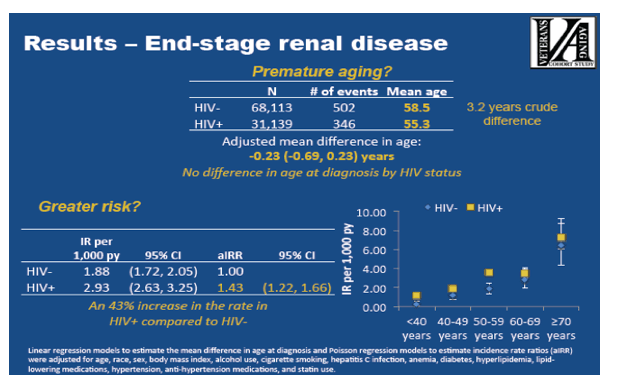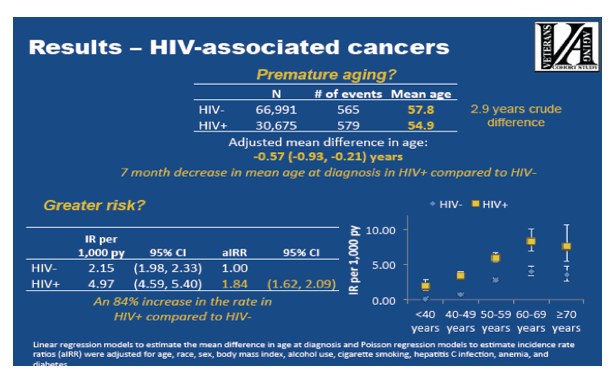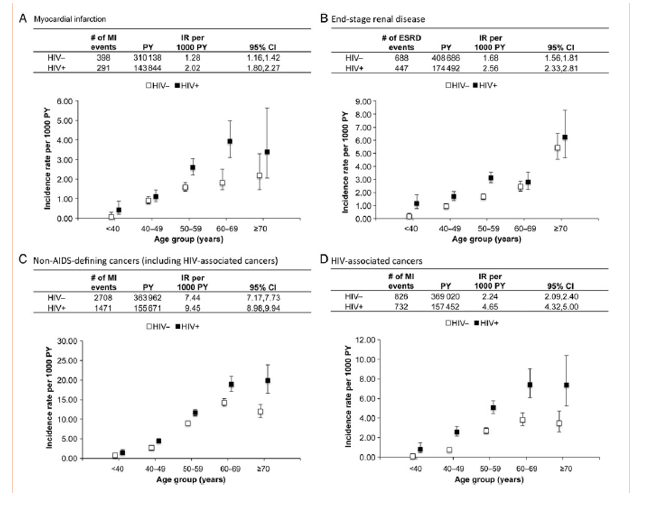| |
CVD & Renal Disease Risk in HIV+ / Comparison of risk and age at diagnosis of myocardial infarction, end-stage renal disease, and non-AIDS-defining cancer in HIV-infected versus uninfected adults
|
| |
| |
Download the PDF here
The risk of MI was also significantly higher in HIV-infected compared with uninfected adults after adjustment for confounders - aHR, 1.76..... The crude IR of ESRD was 2.56 (95% CI, 2.33-2.81) per 1000 person-years in HIV-infected adults and 1.68 (95% CI, 1.56- 1.81) per 1000 person-years in uninfected adults.
"Our study does, however, support previous findings of an increased risk of MI, ESRD, and NADC in HIV-infected compared to uninfected adults, although our estimates are attenuated compared to previous estimates. Our data show that HIV is a risk factor for these outcomes; however, many traditional risk factors have a similar or greater magnitude of relationship with these outcomes. With respect to the validated, clinically relevant diagnoses of MI, ESRD, and NADC, our results support accentuated, not accelerated, aging in HIV-infected adults compared with similar uninfected adults after employing a consistent analytic approach and appropriate adjustment for confounding." from Jules: this was in VA, not general population, where the comparator groups being vets may already have higher risks, so compared to general population HIV+ risks would be higher.]
The risk of MI was also significantly higher in HIV-infected compared with uninfected adults after adjustment for confounders (aHR, 1.76 [95% CI, 1.49-2.07]) .... Factors with a greater magnitude of association than HIV included male sex, diabetes, hyperlipidemia, and eGFR <60 mL/minute/ 1.73 m2.
The crude IR of ESRD was 2.56 (95% CI, 2.33-2.81) per 1000 person-years in HIV-infected adults and 1.68 (95% CI, 1.56- 1.81) per 1000 person-years in uninfected adults. Age-stratified crude IRs showed higher rates of ESRD among HIV-infected participants at all ages (Figure 1B). In multivariate Cox proportional hazards models, HIV modified the effect of age on ESRD (P for interaction = .0002, Figure 3; see Supplementary Data for stratified analyses). Factors with ≥2-fold increase in risk of ESRD (other than HIV and age) included HCV infection, diabetes, and hypertension.
After adjustment for confounders, HIV-infected adults were diagnosed with ESRD at a mean age that was 5.5 months younger than uninfected adults (adjusted mean difference, -0.46 [95% CI, -.86 to -.07] years.
http://www.natap.org/2013/CROI/croi_62.htm




The risk of MI was also significantly higher in HIV-infected compared with uninfected adults after adjustment for confounders (aHR, 1.76 [95% CI, 1.49-2.07]) (Figure 2; see Supplementary Data for point estimates and 95% CIs). The interaction of age and HIV was not statistically significant in multivariate Cox proportional hazards models (P = .086). Factors with a greater magnitude of association than HIV included male sex, diabetes, hyperlipidemia, and eGFR <60 mL/minute/ 1.73 m2.
The crude IR of ESRD was 2.56 (95% CI, 2.33-2.81) per 1000 person-years in HIV-infected adults and 1.68 (95% CI, 1.56- 1.81) per 1000 person-years in uninfected adults. Age-stratified crude IRs showed higher rates of ESRD among HIV-infected participants at all ages (Figure 1B). In multivariate Cox proportional hazards models, HIV modified the effect of age on ESRD (P for interaction = .0002, Figure 3; see Supplementary Data for stratified analyses). Factors with ≥2-fold increase in risk of ESRD (other than HIV and age) included HCV infection, diabetes, and hypertension.
After adjustment for confounders, HIV-infected adults were diagnosed with ESRD at a mean age that was 5.5 months younger than uninfected adults (adjusted mean difference, -0.46 [95% CI, -.86 to -.07] years. The difference in age at diagnosis persisted when weighted linear regression models were used to correct for the small difference in the age distributions by HIV status (Supplementary Data).
Figure 1. Overall and age-specific incidence rates (IRs) (and 95% confidence intervals [CIs]) for myocardial infarction (MI) (A), end-stage renal disease (ESRD) (B), non-AIDS-defining cancers (including human immunodeficiency virus [HIV]-associated cancers) (C), and HIV-associated cancers (D), by HIV status, Veterans Aging Cohort Study Virtual Cohort, April 2003-December 2010. HIV-associated cancers included anal, oral, penis, Hodgkin lymphoma, liver, and lung cancers. To estimate the person-years (PY) denominator for the IRs, participants were followed from their baseline date (ie, a participant's first clinical encounter on or after 1 April 2003) to the first occurrence of the outcome of interest, death, date of last follow-up, or 31 December 2010. Non-AIDSdefining cancers included anal, bladder, brain and nervous system, breast, colorectal, esophageal, Hodgkin lymphoma, kidney, larynx, leukemia (lymphoid
and myeloid), liver, lung, melanoma, myeloma, oral cavity and pharynx, pancreatic, penis, prostate, soft tissue, stomach, testicular, thyroid (there were no cases of vulvar cancer).
Figure 1. Overall and age-specific incidence rates (IRs) (and 95% confidence intervals [CIs]) for myocardial infarction (MI) (A), end-stage renal disease (ESRD) (B), non-AIDS-defining cancers (including human immunodeficiency virus [HIV]-associated cancers) (C), and HIV-associated cancers (D), by HIV status, Veterans Aging Cohort Study Virtual Cohort, April 2003-December 2010. HIV-associated cancers included anal, oral, penis, Hodgkin lymphoma, liver, and lung cancers.

|
|
| |
| |
|
|
|